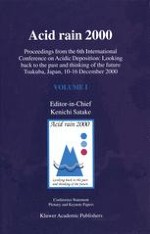2001 | OriginalPaper | Chapter
Tracing Pollution and its Sources with Isotopes
Author : GörAN E. Åberg
Published in: Acid rain 2000
Publisher: Springer Netherlands
Included in: Professional Book Archive
Activate our intelligent search to find suitable subject content or patents.
Select sections of text to find matching patents with Artificial Intelligence. powered by
Select sections of text to find additional relevant content using AI-assisted search. powered by
Naturally occurring isotope systems, such as strontium and lead, are very useful for characterizing sources of pollution and producing background information. The phase-out of lead additives to gasoline in Northern Europe has for example not phased out the lead contamination of the environment. The stable lead isotope method shows the contribution from small local sources to the lead contamination of the Oslo air during a period when the combustion of gasoline, the major source of lead contamination, has been decreasing. Wood combustion for domestic heating is one of these polluting sources in Norway. Strontium analyses show that roadsalt from de-icing of a nearby road is accumulated in the soil surrounding an about 4500 year old rock carving. At rainfall this salt is re-dissolved and drained over the rock carving. The impact from the road is confirmed by lead isotopes. Lead and strontium analysis of teeth show the contribution from industry and traffic on todays humans and the differences in nutrient intake during the Medieval era are compared with today. The isotope signatures of the Medieval teeth also show that a person living along the coast can be distinguished easily from a person living in the central parts of the country, and that the Medieval individual mainly lived on locally produce, while the contemporary person to a great degree lives on industrially manufactured food.
